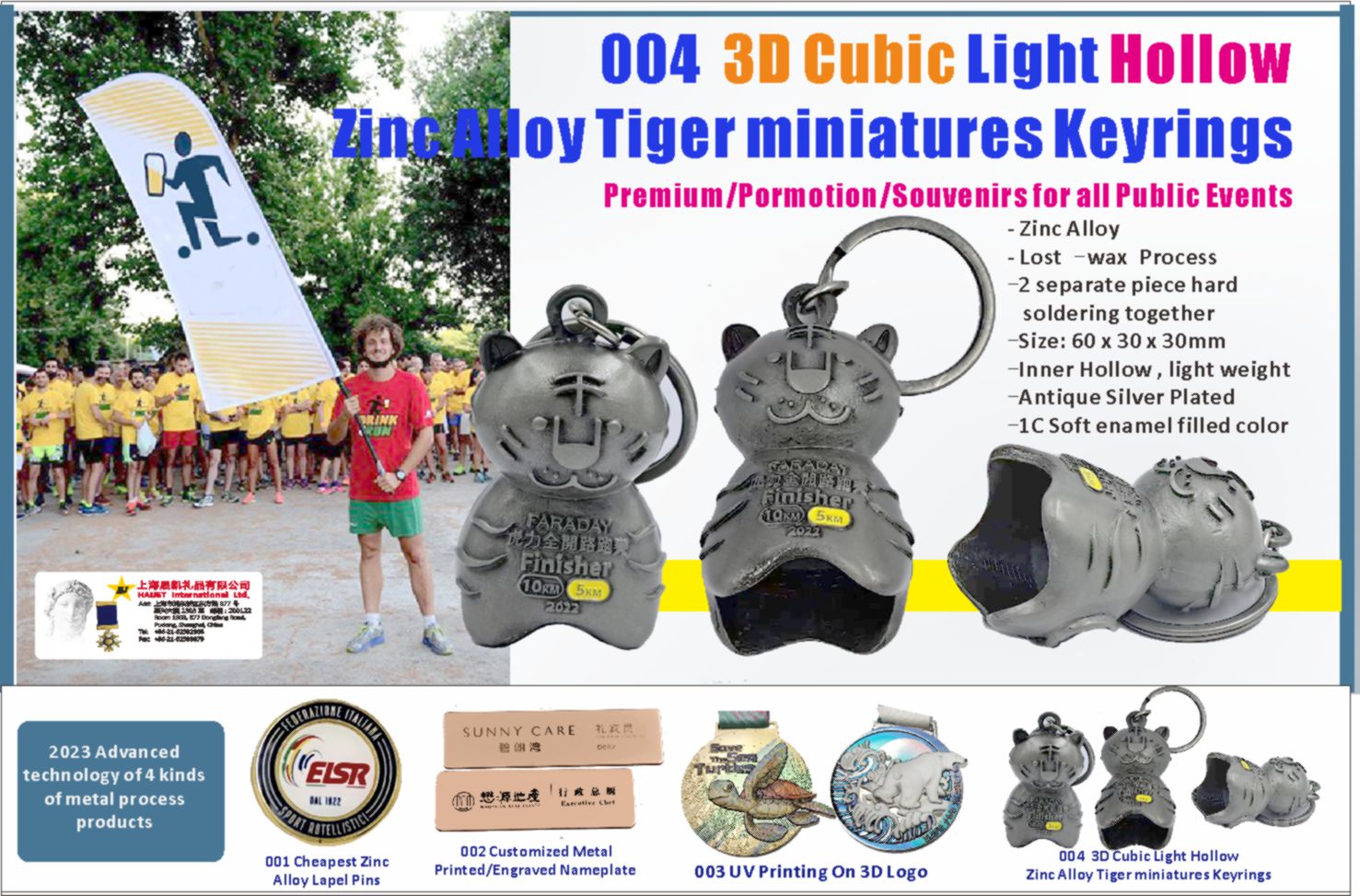<h1 style="text-align:justify; margin-top:23px; margin-bottom:22px"><span style="font-size:26px;"><span style="background:white"><span style="line-height:16.0pt"><span style="font-family:Calibri,"sans-serif""><span lang="EN-US" style="color:#101214">2023 Advanced technology of 4 kinds of metal process products</span></span></span></span></span></h1>
<h1 style="text-align:justify; margin-top:23px; margin-bottom:22px"><span style="font-size:22pt"><span style="line-height:240%"><span style="font-family:Calibri,"sans-serif"">004 3D Cubic Light Hollow Zinc Alloy Tiger miniatures Keyrings</span></span></span></h1>
<p> </p>
<p style="margin-bottom:30px"><span style="font-size:12pt"><span style="background:white"><span style="line-height:16.0pt"><span style="vertical-align:top"><span style="font-family:宋体"><span lang="EN-US" style="font-size:14.0pt"><span style="background:white"><span style="font-family:"Calibri","sans-serif""><span style="color:black">60 x 30 x 30mm Original 3D Hollow Tiger Keychains Keyring For Best Friend</span></span></span></span></span></span></span></span></span></p>
<ul>
<li class="topic-paragraph" style="margin-bottom:7px"><span style="font-size:12pt"><span style="background:white"><span style="line-height:16.0pt"><span style="font-family:宋体"><span lang="EN-US" style="font-size:14.0pt"><span style="font-family:"Calibri","sans-serif""><span style="color:black">Zinc Alloy</span></span></span></span></span></span></span></li>
<li class="topic-paragraph" style="margin-bottom:7px"><span style="font-size:12pt"><span style="background:white"><span style="line-height:16.0pt"><span style="font-family:宋体"><a href="https://www.britannica.com/technology/lost-wax-process" style="color:blue; text-decoration:underline"><span style="font-size:14.0pt"><span style="font-family:"Calibri","sans-serif""><span style="color:black">lost-wax process</span></span></span></a></span></span></span></span></li>
<li class="topic-paragraph" style="margin-bottom:7px"><span style="font-size:12pt"><span style="background:white"><span style="line-height:16.0pt"><span style="font-family:宋体"><span lang="EN-US" style="font-size:14.0pt"><span style="font-family:"Calibri","sans-serif""><span style="color:black">2 separate piece hard soldering together </span></span></span></span></span></span></span></li>
<li class="topic-paragraph" style="margin-bottom:7px"><span style="font-size:12pt"><span style="background:white"><span style="line-height:16.0pt"><span style="font-family:宋体"><span lang="EN-US" style="font-size:14.0pt"><span style="font-family:"Calibri","sans-serif""><span style="color:black">Size: 60 x 30 x 30mm</span></span></span></span></span></span></span></li>
<li class="topic-paragraph" style="margin-bottom:7px"><span style="font-size:12pt"><span style="background:white"><span style="line-height:16.0pt"><span style="font-family:宋体"><span lang="EN-US" style="font-size:14.0pt"><span style="font-family:"Calibri","sans-serif""><span style="color:black">Inner Hollow , light weight</span></span></span></span></span></span></span></li>
<li class="topic-paragraph" style="margin-bottom:7px"><span style="font-size:12pt"><span style="background:white"><span style="line-height:16.0pt"><span style="font-family:宋体"><span lang="EN-US" style="font-size:14.0pt"><span style="font-family:"Calibri","sans-serif""><span style="color:black">Antique Silver Plated</span></span></span></span></span></span></span></li>
<li class="topic-paragraph" style="margin-bottom:7px"><span style="font-size:12pt"><span style="background:white"><span style="line-height:16.0pt"><span style="font-family:宋体"><span lang="EN-US" style="font-size:14.0pt"><span style="font-family:"Calibri","sans-serif""><span style="color:black">1C Soft enamel filled color</span></span></span></span></span></span></span></li>
</ul>
<p class="topic-paragraph"><span style="font-size:12pt"><span style="background:white"><span style="line-height:16.0pt"><span style="font-family:宋体"><span lang="EN-US" style="font-size:14.0pt"><span style="font-family:"Calibri","sans-serif""><span style="color:black">The </span></span></span><a href="https://www.britannica.com/technology/lost-wax-process" style="color:blue; text-decoration:underline"><span style="font-size:14.0pt"><span style="font-family:"Calibri","sans-serif""><span style="color:black">lost-wax process</span></span></span></a><span lang="EN-US" style="font-size:14.0pt"><span style="font-family:"Calibri","sans-serif""><span style="color:black"> is the traditional method of casting metal sculpture. It requires a positive, which consists of a core made of a refractory material and an outer layer of wax. The positive can be produced either by direct </span></span></span><a href="https://www.britannica.com/art/modeling-sculpture" style="color:blue; text-decoration:underline"><span style="font-size:14.0pt"><span style="font-family:"Calibri","sans-serif""><span style="color:black">modeling</span></span></span></a><span lang="EN-US" style="font-size:14.0pt"><span style="font-family:"Calibri","sans-serif""><span style="color:black"> in wax over a prepared core, in which case the process is known as direct lost-wax casting, or by casting in a piece mold or flexible mold taken from a master cast. The wax positive is </span></span></span><a href="https://www.britannica.com/dictionary/invested" style="color:blue; text-decoration:underline"><span style="font-size:14.0pt"><span style="font-family:"Calibri","sans-serif""><span style="color:black">invested</span></span></span></a><span lang="EN-US" style="font-size:14.0pt"><span style="font-family:"Calibri","sans-serif""><span style="color:black"> with a mold made of refractory materials and is then heated to a </span></span></span><a href="https://www.britannica.com/science/temperature" style="color:blue; text-decoration:underline"><span style="font-size:14.0pt"><span style="font-family:"Calibri","sans-serif""><span style="color:black">temperature</span></span></span></a><span lang="EN-US" style="font-size:14.0pt"><span style="font-family:"Calibri","sans-serif""><span style="color:black"> that will drive off all moisture and melt out all the wax, leaving a narrow cavity between the core and the investment. Molten metal is then poured into this cavity. When the metal has cooled down and solidified, the investment is broken away, and the core is removed from inside the cast. The process is, of course, much more complex than this simple outline suggests. Care has to be taken to suspend the core within the mold by means of metal pins, and a structure of channels must be made in the mold that will enable the metal to reach all parts of the cavity and permit the mold gases to escape. A considerable amount of filing and chasing of the cast is usually required after casting is completed.</span></span></span></span></span></span></span></p>
<p class="topic-paragraph"><span style="font-size:12pt"><span style="background:white"><span style="line-height:16.0pt"><span style="font-family:宋体"><span lang="EN-US" style="font-size:14.0pt"><span style="font-family:"Calibri","sans-serif""><span style="color:black">While the lost-wax process is used for producing complex, refined metal castings, </span></span></span><a href="https://www.britannica.com/technology/sand-casting" style="color:blue; text-decoration:underline"><span style="font-size:14.0pt"><span style="font-family:"Calibri","sans-serif""><span style="color:black">sand</span></span></span></a><span lang="EN-US" style="font-size:14.0pt"><span style="font-family:"Calibri","sans-serif""><span style="color:black"> molding is more suitable for simpler types of form and for sculpture in which a certain roughness of surface does not matter. Recent improvements in the quality of sand castings and the invention of the “lost-pattern” process (see below) have resulted in a much wider use of sand casting as a means of producing sculpture. A sand mold, made of special sand held together by a binder, is built up around a rigid positive, usually in a number of sections held together in metal boxes. For a </span></span></span><a href="https://www.britannica.com/dictionary/hollow" style="color:blue; text-decoration:underline"><span style="font-size:14.0pt"><span style="font-family:"Calibri","sans-serif""><span style="color:black">hollow</span></span></span></a><span lang="EN-US" style="font-size:14.0pt"><span style="font-family:"Calibri","sans-serif""><span style="color:black"> casting, a core is required that will fit inside the negative mold, leaving a narrow cavity as in the lost-wax process. The molten metal is poured into this cavity.</span></span></span></span></span></span></span></p>



